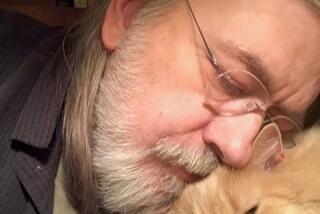It Was 20 Years Ago Today
My eldest son, Colin, who is now 33, was 12 when he first read “The World According to Garp”--in manuscript, and with me anxiously awaiting his reaction. (I still believe there are scenes in the book that are unsuitable for 12-year-olds.) Although “Garp” was my fourth novel, it was the first one Colin could read, and I remember feeling both proud and nervous at the prospect of being judged by one of my children; that the book was dedicated to Colin, and to his younger brother Brendan, made the moment even more tense and exciting.
Surely everyone knows the two most common questions that are asked of any novelist. What is your book about? And is it autobiographical? These questions and their answers have never been of compelling interest to me--if it’s a good novel, both the questions and the answers are irrelevant--but while my 12-year-old son was reading “The World According to Garp,” I anticipated that these were the very questions he would ask me, and I thought very hard about how I might answer him.
Now, 20 years later--and having written nine novels--it occurs to me that I have never thought as hard about my answers to those “irrelevant” questions as I did when Colin was reading “Garp.” What I mean, of course, is that it’s perfectly understandable and completely permissible for a 12-year-old to ask those questions, whereas (in my opinion) an adult has no business asking them. An adult who reads a novel should know what the book is “about”; an adult should also know that whether a novel is autobiographical or not is beside the point--unless the alleged adult is hopelessly inexperienced or totally innocent of the ways of fiction.
Anyway, while Colin was off in his room reading the manuscript of “Garp,” I found myself agonizing over what the novel was “about.” To my horror, and full of self-loathing, I jumped to the conclusion that the book was about the temptations of lust--lust leads just about everyone to a miserable end. There is even a chapter called “More Lust,” as if there weren’t enough already. I was positively ashamed of how much lust was in the book, not to mention how punitive a novel I thought it was; indeed, every character in the story who indulges his or her lust is severely punished. And, among the culprits and the victims, physical mutilations abound: Characters lose eyes and arms and tongues--even penises!
It had seemed at one time, when I was beginning the novel, that the polarization of the sexes was a dominant theme; the story was about men and women growing farther and farther apart. Just look at the plot: A remarkable, albeit outspoken, woman (Garp’s mother, Jenny Fields) is killed by a lunatic male who hates women, and Garp himself is assassinated by a lunatic female who hates men.
“In this dirty-minded world,” Jenny thinks, “you are either somebody’s wife or somebody’s whore--or fast on your way to becoming one or the other. If you don’t fit either category, then everyone tries to make you think there is something wrong with you.” But there is nothing wrong with Garp’s mother. In her autobiography, Jenny writes: “I wanted a job and I wanted to live alone. That made me a sexual suspect. Then I wanted a baby, but I didn’t want to have to share my body or my life to have one. That made me a sexual suspect, too.” And being what she calls “a sexual suspect” also makes Jenny a target of anti-feminist hatred--just as Garp, her son, becomes a target of radical feminists.
But the principal point about Garp’s mother is stated in the first chapter: “Jenny Fields discovered that you got more respect from shocking other people than you got from trying to live your own life with a little privacy.” Today, 20 years later, Jenny’s discovery seems more true--not to mention more defensible--than it seemed to me in 1978. And I don’t always agree with Jenny. “Between men and women,” she says, “only death is shared equally.” Late in the novel, in the last chapter, I disagree with her as follows: “. . . between men and women, not even death gets shared equally. Men get to die more, too.”
There was a time when Jenny threatened to take over the novel, when I wasn’t at all sure if Garp or his mother was the main character; something of my indecision remains. I once wanted to begin the book with Chapter 11 (the “Mrs. Ralph” chapter), but that would have necessitated a flashback of 313 pages. I next tried beginning the novel with Chapter 9, the chapter called “The Eternal Husband”. My first sentence was: “In the Yellow Pages of Garp’s phone directory, Marriage was listed near Lumber.” I used to think the novel was about marriage, specifically the perils of marriage, more specifically, the threat of lust to marriage. “Garp had never realized,” I wrote, “that there were more marriage counselors than lumber-yards.” (Is it any wonder I was anxious that a 12-year-old was reading this book?)
And, at another time, “The World According to Garp” began with Chapter 3 (“What He Wanted to Be When He Grew Up”)--for isn’t the novel also about that? Garp wants to be a writer; it is a novel about a novelist, although almost no reader of the book remembers it as such. Yet Garp’s origins as an author are crucial to the story--”the beginning of a writer’s long-sought trance, wherein the world falls under one embracing tone of voice.” And from the beginning, there was an epilogue. I knew everything that happened before I began--I always do. “An epilogue,” Garp writes, “is more than a body count. An epilogue, in the disguise of wrapping up the past, is really a way of warning us about the future.”
But to begin the novel as I once tried, with Chapter 3, was too historical, too emotionally remote. “In 1781 the widow and children of Everett Steering founded Steering Academy, as it was first called, because Everett Steering had announced to his family, while carving his last Christmas goose, that his only disappointment with his town was that he had not provided his boys with an academy capable of preparing them for a higher education. He did not mention his girls.” There again is the sexual-polarization theme--as early as 1781!
Meanwhile, in the privacy of his room, Colin was reading on and on. “The World According to Garp” would never have satisfied a 12-year-old if it had been only a novel about a novelist, although much of what mattered to me about the book was exactly that. I shall always see Garp prowling in his neighborhood at night, taking a dim view of his neighbors’ television sets. “There is the faint, trapped warble from some televisions tuned in to The Late Show, and the blue-gray glow from the picture tubes throbs from a few of the houses. To Garp this glow looks like cancer, insidious and numbing, putting the world to sleep. Maybe television causes cancer, Garp thinks; but his real irritation is a writer’s irritation: he knows that wherever the TV glows, there sits someone who isn’t reading.”
And what of the Under Toad? Colin was familiar with its source. It was his brother Brendan who misunderstood him one summer at the beach on Long Island. “Watch out for the undertow, Brendan,” Colin warned him--at the time, Brendan was 6. (Colin was 10.) Brendan had never heard of an undertow; he thought Colin said Under Toad. Somewhere, under the water, lurked a dangerous toad.
“What can it do to you?” Brendan asked his brother.
“Pull you under, suck you out to sea,” Colin said.
That did it for Brendan at the beach--he wouldn’t go near the ocean. It was weeks later when I saw him standing at some distance from the water’s edge, staring into the waves.
“What are you doing?” I asked him.
“I’m looking for the Under Toad,” Brendan said. “How big is it? What color is it? How fast can it swim?”
“The World According to Garp” wouldn’t exist without the Under Toad. Brendan got me started.
To my surprise, Colin didn’t ask me what the book was “about”--he told me. “It’s about the fear of death, I think,” Colin began. “Maybe more accurately, the fear of the death of children--or of anyone you love.”
I remembered then that, among my other attempts to begin the novel, I had long ago begun with what would become the last sentence (“. . . in the world according to Garp, we are all terminal cases”), and I recalled how that sentence had moved through the book; I kept pushing it ahead. It was once the first sentence of the second chapter; later it was the last sentence of the 10th chapter, and so on, until it became the end of the novel--the only possible ending. Not surprisingly, Garp describes a novelist as “a doctor who sees only terminal cases.”
Yet Colin, my 12-year-old, surprised me by telling me what my book was about. The “Mrs. Ralph” chapter, my first false beginning, begins as follows: “If Garp could have been granted one vast and naive wish, it would have been that he could make the world safe. For children and for grown-ups. The world struck Garp as unnecessarily perilous for both.” At age 12, Colin had zeroed in on that. Garp lives in “a safe suburb of a small, safe city,” but neither he nor his children are safe. The Under Toad will get him in the end--as it gets his mother, as it gets his younger son. “Just be careful!” Garp is always telling his children, as I am still telling mine.
It is a novel about being careful and about that not being enough.
The real beginning to the book, the one I finally chose, describes Jenny’s habit of carrying a scalpel in her purse. Jenny is a nurse and an unmarried woman who wants nothing to do with men; she carries the scalpel for self-defense. And so “The World According to Garp” begins with an act of violence--Jenny cuts a soldier, a stranger who thrusts his hand under her dress (her nurse’s uniform). “Garp’s mother, Jenny Fields, was arrested in Boston in 1942 for wounding a man in a movie theater.” Finally, it was just that simple; I began at the beginning of the main story, before Jenny is pregnant with Garp--at the moment she decides she wants to have a baby without having a husband.
Interestingly, Colin never asked me if the novel was autobiographical. But a year after the publication of “The World According to Garp,” I visited the Northfield Mount Hermon School--a private secondary school in Massachusetts. I had been invited to give a reading to the students, and I’d accepted the invitation because Colin had recently been admitted to the school--he would be a student there in the coming academic year--and I thought it would be an opportunity for Colin to see something of the place and meet a few of the young men and women who would soon be his fellow students. Therefore Colin came with me to the reading, after which there were some questions from the audience. (It had been announced to the audience that Colin would be attending Northfield Mount Hermon in the fall--he’d already been introduced to the crowd.) Unexpectedly, a very pretty young woman asked Colin a question--she didn’t ask me.
“Is Garp your dad--is your father Garp?” the girl asked.
Poor Colin! He must have been embarrassed, but you would not have known it from his unflappable composure; he was a little younger than the assembled students, but he suddenly struck me as much older and more wary than most of them. Furthermore, he was an expert on “The World According to Garp.”
“No, my dad isn’t Garp,” Colin replied, “but my father’s fears are Garp’s fears--they are any father’s fears.” (Colin was 14, going on 33.)
So that’s what “The World According to Garp” is about--a father’s fears. As such, the novel is and isn’t “autobiographical.” Just ask Colin, or Brendan, or--in a few years, when he’s old enough to read it--my youngest son, Everett. (As of this writing, Everett is six.)
I may have written this novel 20 years ago, but I go back there almost every day, back to those fears. Even the smallest detail of “The World According to Garp” is an expression of fear; even the curious pockmark on the face of the Viennese prostitute--it is also an expression of that most terrible fear. “The silvery gouge on her forehead was nearly as big as her mouth; her pockmark looked to Garp like a small, open grave.” A child’s grave . . .
When “Garp” was published, people who’d lost children wrote to me. “I lost one, too,” they told me. I confessed to them that I hadn’t lost any children. I’m just a father with a good imagination. In my imagination, I lose my children every day.
More to Read
Sign up for our Book Club newsletter
Get the latest news, events and more from the Los Angeles Times Book Club, and help us get L.A. reading and talking.
You may occasionally receive promotional content from the Los Angeles Times.






